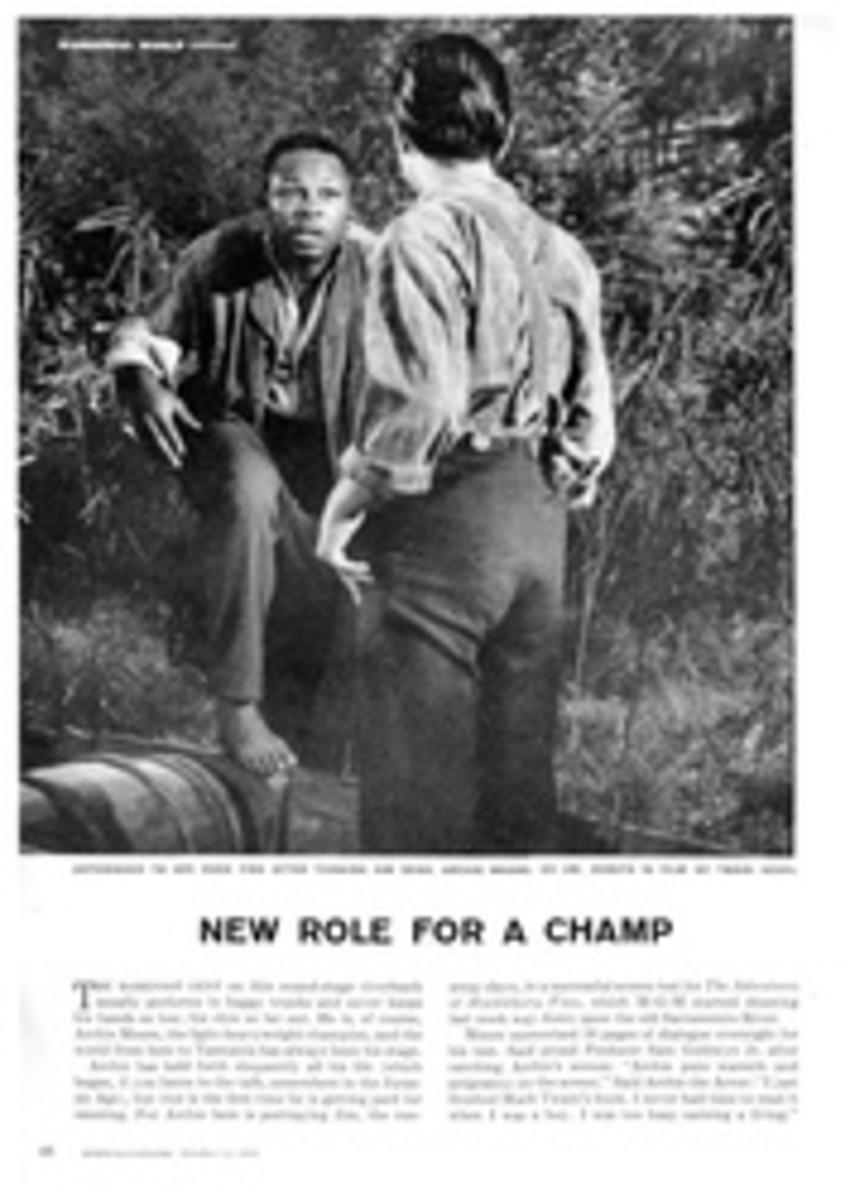
Chevy puts its power in the back
The most novel car to be introduced by Detroit this fall is Chevrolet's Corvair. This is General Motors' first entry into the compact car sweepstakes, and it is a rear-engined honey which represents real pioneering.
There was considerable eyebrow-lifting when the word got around that the Corvair would be a rear aluminum engine job. Some said that a rear-engine car of Corvair's size would tend to oversteer, that it would waver on windy days and wouldn't corner properly. Rear engines were fine, they said, for cars weighing less than 1,700 pounds, but for a 2,340-pound Corvair, well....
On the test track, I drove the Corvair in a range of speeds up to 85 mph, and the handling was beautiful. At medium high speeds she took flat turns smoothly. On rough gravel at 60 she held the road fine. And at 85 on open stretches and in steering situations there was no wander or shift.
One thing most auto companies don't like to talk about is acceleration performance. I clocked the Corvair, when the test driver took the wheel, at 18 seconds from standing start to 60 mph. We were in a Corvair with two-speed automatic transmission (the standard transmission will do this trick in 17 seconds). Accelerating at 50 mph in a passing situation the Corvair will travel 1,250 feet in 10 seconds. And from a standing start the Corvair will do the first 1,000 feet in 10 seconds.
When braked to the floor at 70 mph on a medium downgrade the Corvair showed no untoward effects. The stop was satisfactory and, best of all, there was no dip. One undeniable characteristic of front-engine cars is the dip or "dive" from fast braking, because the engine weight pulls the front end down. Late-model front-engine cars have antidive built in, but none can totally eliminate the characteristic.
I was aware that some rear-engine cars are downright noisy. With the windows rolled up to cut out road noise, I couldn't hear a sound from the rear in this one. A sound-absorbing bulkhead of fiber glass between the engine and the rear housing kept her quiet. And I was surprised not to hear the expected tire squeal on curves.
To achieve these good handling characteristics, Chevy engineered a weight distribution of 40% on the front axle, 60% on the rear; with a heavier, cast-iron engine this ideal weight distribution wouldn't have been possible. A second rear-engine problem—that of overloading the rear tires and causing front-end "wander"—was solved by use of Tyrex cord tires mounted on wider rims. With trucks and their heavy rear-end cargoes, four or eight tires are used; Corvair, with a smaller but similar problem, uses the wide rim and special tires inflated to 26 pounds; front tires carry only 15 pounds.
Corvair's weight distribution is also an aid in braking. A stopping car shifts its weight to the front, and with that rear-engine weight going forward the four wheels more equally share the braking job.
One interesting Corvair engineering feature is the independent suspension system for the rear wheels. The chief advantage of such a "swing" suspension is that it allows each rear wheel to hop independently on bumps and thus reduce the number of jolts transmitted to the frame and passengers.
The aluminum rear engine has its six pistons opposed in a horizontal plane, like so many fists punching a common punching bag. Its displacement is 140 cubic inches. Because this engine is not deep and is circular in shape, it is called a "pancake." You can sit on the ridge of the rear deck opening, reach over and work on this engine. Some call this "hind-end servicing." The engine isn't shiny at all because it is covered with weatherproof black sheet metal.
"When you open up its rear end," rhapsodized a Chevy engineer, "there is all its little machinery sitting there smiling at you."
The acknowledged advantage of a rear engine is that its power is directly transmitted to the wheels with greater efficiency. In the case of Corvair, the entire power unit—engine, transmission and axle—are compacted into a whole through use of the "trans-axle" (combination transmission and axle). And the engine weighs only 332 pounds, about half of what a conventional six does. Just three bolts are used to fix this engine to the frame, so the engine can be removed in less than one hour.
This engine has 80 hp, smallest of the three Detroit compacts. But power pack units will be offered later, perhaps because of what looks like an incredible but developing horsepower race among compacts. The Falcon has 90 hp, the Valiant at least 100. Corvair must catch up and its optional power pack will probably increase horsepower to 90.
The Corvair will give up to 30 miles per gallon and will provide other operating economies. The air-cooled engine means no radiator or water pump and no need for antifreeze. Repair bills should be less because of engine accessibility and consequential cuts in labor costs.
With no radiator, warm air must be provided by a heater, which burns gasoline at a maximum rate of one quarter gallon an hour. Chevy pooh-poohs charges that such heaters and the front-located gas tank are dangerous. The location of the gas cap on the left front fender and the vented deck in the rear are the visual clues that this is a rear-engine car.
Unitized construction and all-weld design describe the body, and simple, clean lines describe the styling. The Corvair's flat roof edges over the rear window, and both the hood and rear deck have a slight downward slope. There are dual headlights and a quiet, plain face up front, sans grille, of course. The Corvair 700—the de luxe line—has an austere strip of chrome running knee high on the sides, from snout to tail. The Corvair 500—the standard line—has no chrome trim to speak of. The wrap-around windshield has followed the engine to the rear, and the front windshield is plain Jane. This car not only is economy but looks it.
Four thin doors invite you into the Corvair. Tall people will strain some on the way in but once seated will find generous headroom. A prominent Chevy engineer once significantly and sensibly explained why one small car has four doors. He said: "Small car bodies do not permit crawling across without loss of dignity. So each of the passengers sits back in his appropriate hole and slams the door on himself. This is the way one handles these small cars. You do not so much get into them as put them on, like an article of clothing."
Inside, the Corvair reflects more economy. Fabrics and upholstery are not as plush as those of its competition. The dash is simple Chevy all the way. The emergency brake is a ratchet, pull-across type. Money was saved by not installing a flashing red light to indicate the emergency brake is on; instead, the brake handle shows an arrow when the brake is on and none when you release it. The two-speed automatic transmission shift control is thumb-operated. In standard models the gearshift is on the floor instead of on the steering post. For once the ashtray is where it belongs—up almost to eye level.
NOT WITHOUT SIN
Detroit's Big Three all claim room for six passengers in their smaller car offerings. The fact is that five can be comfortable in the Corvair, and six is a squeeze. In the Corvair the leg room in front is two inches less than that of the 1959 Chevy. Rear leg room in the Corvair is skimpy compared with that of the 1959 Chevy.
Corvair's headroom story is more encouraging. Because of the flat floor and very low seating, handy byproducts of having no transmission tunnel, the Corvair's headroom is more than adequate.
This car is not without sin, however, and the cardinal one is short luggage space. The engineless front compartment houses the brake fluid system, steering gear component, windshield wiper assembly, spare tire and heater. What's left is storage space and is less than half that offered by Corvair's competitors. To make up for this, Corvair has a small storage well to the rear of the back seat inside and also offers, optionally and at extra cost, a fold-down back seat which provides cargo area like that of a station wagon. But with the back seat folded down, you wind up with a two-or three-passenger car. Those who want Corvair with ample luggage room had best wait until the Corvair wagon—now in the works—makes its appearance.
Another shortcoming of the Corvair is the fact that with a stick shift on the floor it is downright difficult to seat three people comfortably in the front, especially if the lady in the middle is wearing a skirt.
ILLUSTRATION
DAN TODD
INTRODUCING A FLAT "PANCAKE" ALUMINUM ENGINE SET IN THE REAR OF THE CAR, CHEVROLET'S CORVAIR IS LIKELY TO CAUSE A REVOLUTION IN AN INDUSTRY USED TO STEREOTYPES
1959 CHEVY IS 211 INCHES LONG
CORVAIR MEASURES 180 INCHES
VOLKSWAGEN IS 100 INCHES LONG

